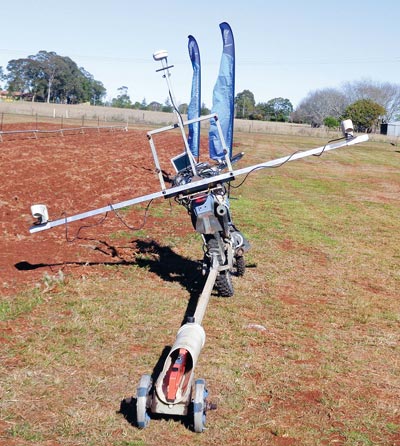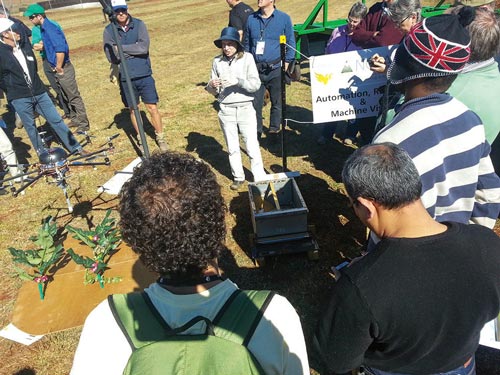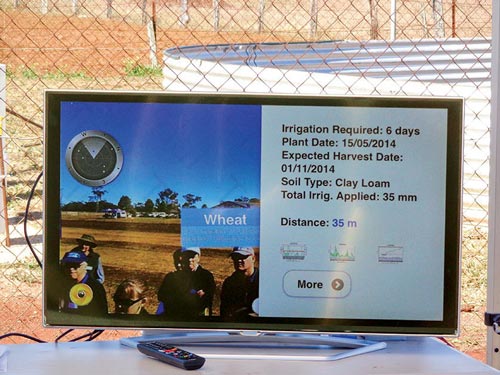In late June, while the great majority of the conservation agriculture community converged on Winnipeg, Canada, in the Northern Hemisphere, Dr. Francelino Rodrigues, a CIMMYT post-doctoral fellow in precision agriculture in the Biometric and Statistics Unit of the Genetic Resources Program, and Dr. Jack McHugh, a CIMMYT cropping systems agronomist in the Global Conservation Agriculture Program, ventured into the much colder Southern Hemisphere to take part in the Digital Rural Futures Conference at the University of Southern Queensland (USQ) in Toowoomba, Queensland, Australia.

Although the conference itself held considerable incentive to visit Australia, it was the National Centre for Engineering in Agriculture (NCEA) at USQ that was of greater interest, because of the possibilities for future collaborations in precision farming research and development (R&D). The NCEA was established in 1994 and specializes in engineering research relevant to the agribusiness sector and the natural resource base it utilizes. The center promotes research through extension, training and commercialization. Having worked at NCEA prior to CIMMYT, McHugh thought there were benefits in closer collaboration between CIMMYT and NCEA to take advantage of the precision agriculture R&D being conducted there.
Prior to the conference, Rodrigues and McHugh presented their work from Mexico and China, respectively, to NCEA staff. The discussion highlighted the complementary nature of the two organizations in the areas of precision agriculture, field monitoring, smart technologies and remote sensing. A tour of the NCEA ‘smart farms’ was the highlight of the conference for McHugh, who was able to see that much of his earlier work had been developed into significant applied instrumentation. 
Rodrigues commented on the versitile multi-proximal sensor platform developed by McHugh at the NCEA: “The platform [on a motorbike] allows simultaneously on-the-go measurements of apparent soil electro-conductivity and the normalized difference vegetation index (NDVI), which gives a tremendous advantage compared with stop-and-go measurements. It’s something we started to do with a wood sled in the past year at CIMMYT’s experiment station in Obregón, but the motorbike would definitely create a new opportunity for fast and efficient measurements during crop growth.”
According to the NCEA, the farming system of the future will have robotic sensing systems and decision support tools that interface seamlessly with commercial on-farm operations to optimize resource usage. The NCEA is working on components of this, but much of what the CIMMYT researchers saw could be applied immediately to current farming systems and already includes considerable integration. Some of the systems displayed were controlled remotely by tablets and interfaced on large screen monitors that displayed real-time feedback of sensors, machinery and field activities including the following: smart weed spot sprayers that are able to differentiate crops from weeds based on reflectance and leaf shape; aerial vehicles with multispectral and thermal sensors; and irrigation monitoring for water scheduling.

Other sensors on display included NDVI sensor platforms, automated cone penetrometers, sensor-equipped bee traps and automated adaptive control of furrow irrigation systems. Of particular note was the augmented reality (AR) for real-time interactivity with on-farm devices and information. AR automatically filters information from online sources based on the user’s current location and viewing perspective, using the camera in a tablet or smartphone. AR markers in the ‘real-world’ (e.g., weather stations, pumps, field sensors, crops and more) can be discovered and online information can be retrieved. The data is merged into the device’s real-world observation, and the user can interact with the content to control and configure machinery. The next step is to build collaboration between both institutes. McHugh and Rodrigues are looking forward to the identification and application of the NCEA technology through future research exchanges and project development.
 Innovations
Innovations